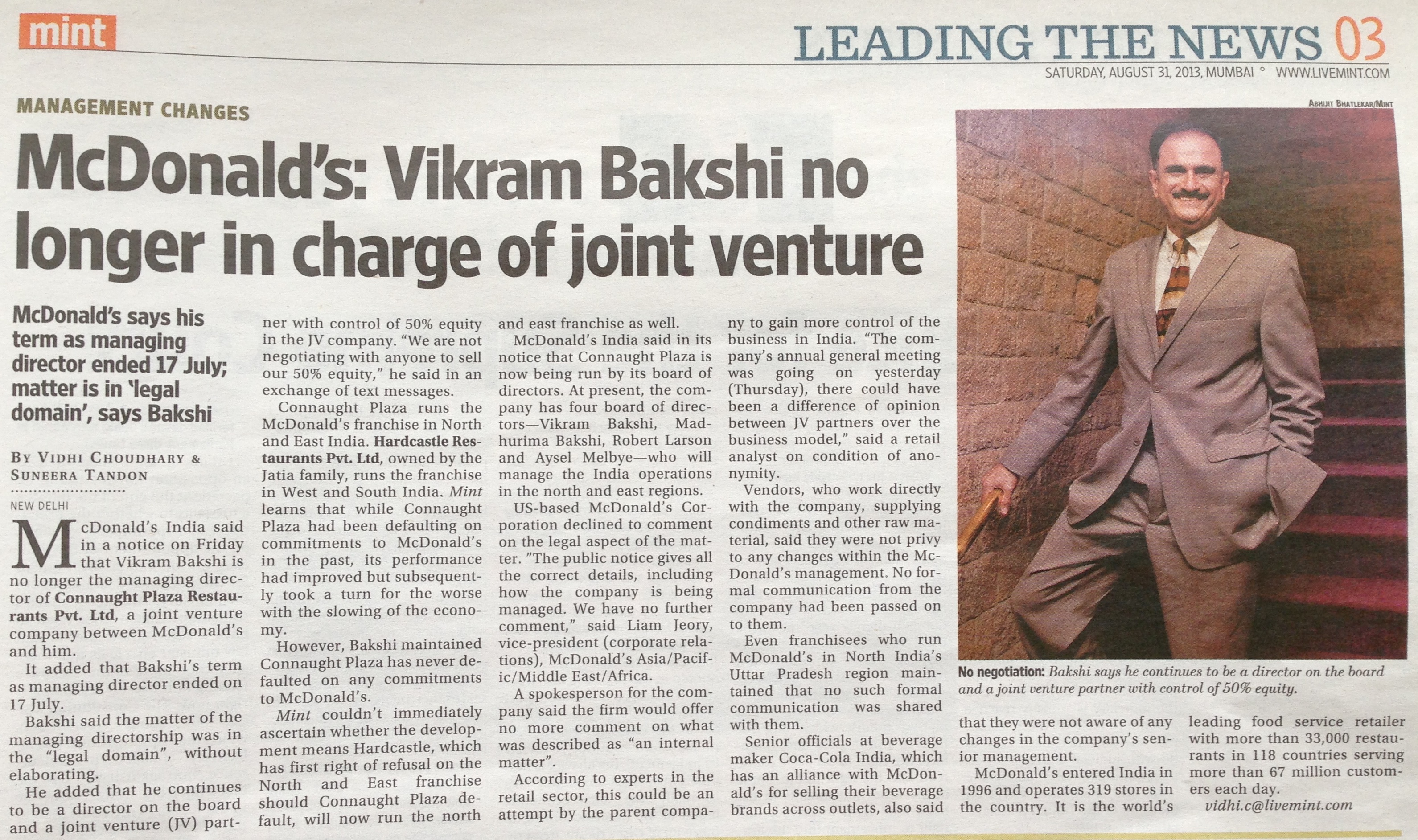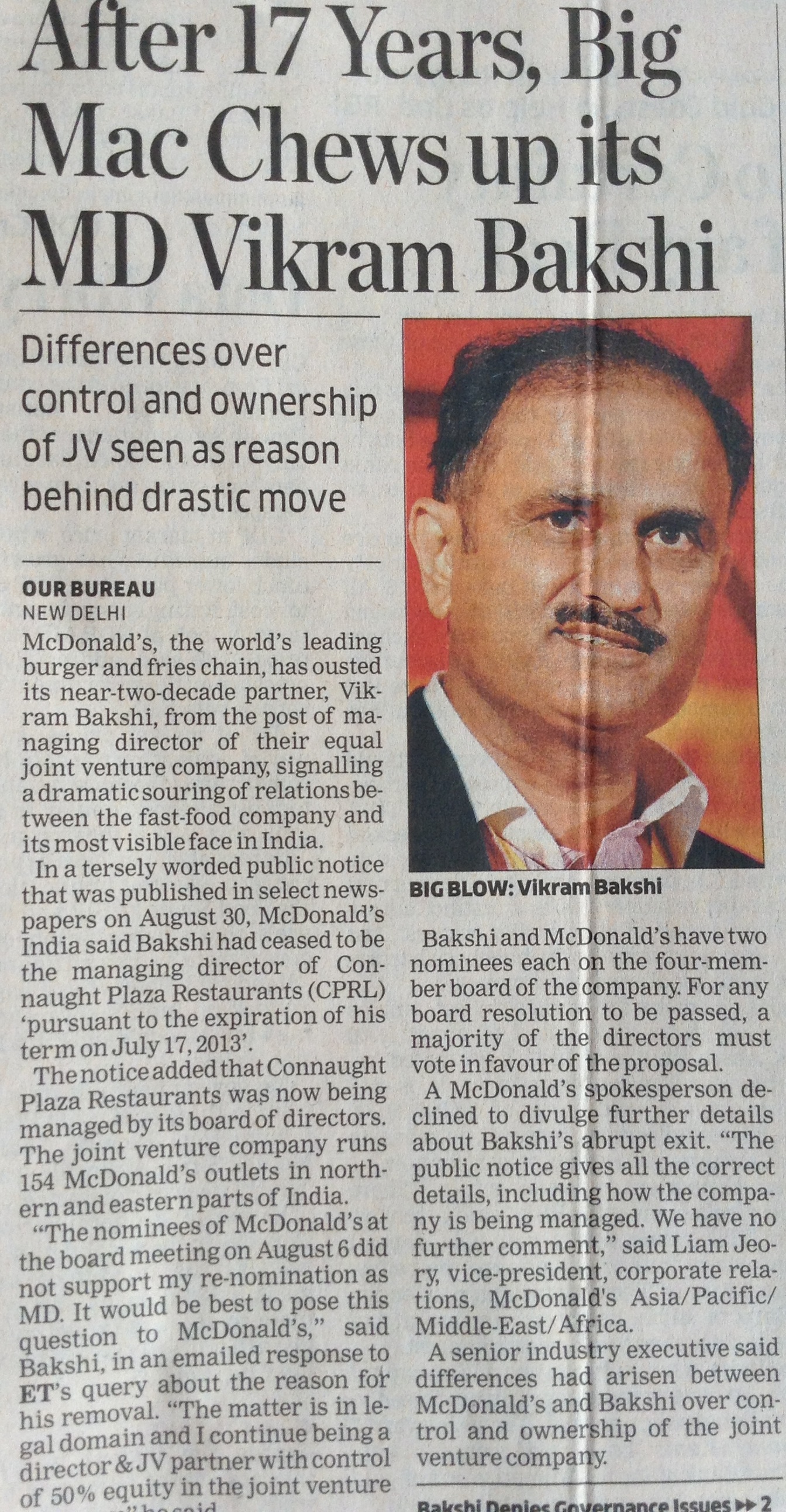I was taken aback this morning when I read that McDonald’s has ‘removed’ its North Indian Franchise Owner – Vikram Bakshi as the MD from the board. The matter is now “in legal quarters”!
2 news reports from the Mint and ET: (Click on the images to expand)
This news item intrigues me immensely.
These are 5 questions that I have keeping India Entrepreneurs in mind who ARE wishful of bringing foreign brands into India via the Franchise route:
1. How do the Boards of Indian McDonald’s Franchise Companies operate?
If there is a 50-50% ownership (as stated) of the Company and the board composition is 4 members – 2 each from the Company and McD, then who has Veto rights?
How do they resolve deadlocks?
In a conflicted case like the one above, how will McD North India RUN?
2. Who has ROFR? (Rights of First Refusal)
Can McD buy out its franchise owners or vice versa and at what valuations?
Are there drag outs and latch on rights? Does McD have special privileges?
Please read this for a thorough understanding of these terms
3. How can impropriety be suggested when ALL decisions are made jointly by the board (as suggested above)?
I am not suggesting that fraud MAY NOT have happened, but what are the checks and measures? Can this be a vindictive approach or a long term planned fraud?
4. McD North India revenues for March 2012 were 390 crores with a net profit of 6.4 crores.
Let’s assume that West India will be the same (should be a bit lower) and South India even lower (Lower because Burger Eating is a Non-Veg culture):
Then the combined revenues of the MacDonald’s business in India will be 800-900 crores with a net profit of 15-20 crores?
This seems similar to Domino’s in 2011 (See this article I wrote), where in 2011 the Topline of Domino’s India was 900 crores with a NET PROFIT of 90 crores.
After 17-20 years of operations, this does not seem significant CONSIDERING the bigness of the brand and the massive capital that entrepreneurs have to contribute?
(900 crores = 140 million US$)
Is all the pain, effort, capital costs, restrictions, lock-ins, etc etc worth this?
5. What PRECEDENCE does this set for future Indian entrepreneurs who are getting hundreds of foreign Franchises into India and contributing their blood, sweat, toil and tears in cultivating these brands and businesses in India?
I refer to Brands like Presto, Subway, etc etc (caveat – I am not sure that these are necessarily franchises but I do read that foreign gyms, food brands, etc etc are all being bought into India with starry eyed entrepreneurs who want to “IPO”)
If you are familiar with this business or foreign franchise model, can you answer?
*****







Prashant Chanchal
Hi Alok,
I have a quick question – did you miss putting ‘NOT’ by mistake, when you said
Prashant
Rajiv Lulla
Holy Mac !!! How do you kick out a 50% partner ??? Bu(r)gger !!!
asha chaudhry
many thanks for pointing out prashant. correction made 🙂
Ashwin C Parulkar
It’s worth while to toil initially for an enterprenuer for-
1 take an advantage of first entrant..with definite Exit strategy in mind…in this case V Bakshi has.
2 Mr Bakshi will give tough time for Mc- breech of contract from Mc side will cost them hell+ legal process in India
3mr Bakshi is not happy with the throw away valuation Mac did,
Its worth noticing the pattern-
Reebok has similar incidence of Rs 850cr mismanagement fraud so as Mc
It sets the bad case for Indian ente. Subject to big Trust deficit
Now FDi has eased out the single brand norms to 51% will make possible for thsesse brands to enter directly?
shridharan Ramamurthi
One-I seriously doubt the numbers these companies put out for our consumption.Even with all the brand building which is very localised i am sure the margins are far highers than the article suggests.Two there is always a significant threshold number,in this business i think it will be in terms of area coverage and number of franchisees-when the business will just start growing exponentially.Three-this reminds me of the Coca-Cola war in India-between the parent company and the bottlers-finally the bottlers gave way and the franchisees are just a fraction of what they were.Raises lots of questions.